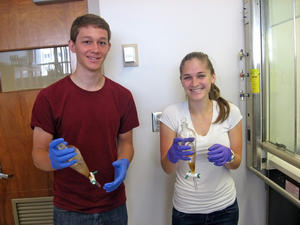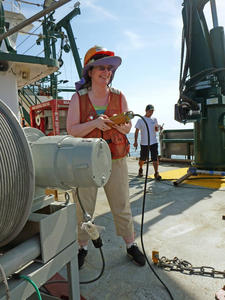Undergraduate, graduate students get hands-on experience studying effects of Gulf oil spill
Scientists studying the impact of oil in the Gulf of Mexico perform experiments on everything from sand to water to sea life. Recently, one group of researchers extended their experimental spirit to that old university standby, the internship.

FSU junior Curtis Okolovitch and recent Georgia Tech graduate Kala Marks prepare to extract Macondo oil from Gulf samples to check for the presence of oil-eating microbes. An undergraduate and graduate from two different universities, working at Georgia Tech with samples provided by researchers at the University of West Florida, the two illustrate the level of cooperation among consortium members to create a rewarding internship experience.
The 2013 Deep Sea to Coast Connectivity in the Eastern Gulf of Mexico (Deep-C) Interns — undergraduates, graduate students, even teachers — worked one-on-one with scientists in a flexible new program tailored to meet all parties’ scheduling needs. Meredith Field, Assistant in Research and Outreach and coordinator of the Deep-C Internship Program, explained that the program matched applicants with consortium scientists to join ongoing projects at a time that worked for both the students and the research team. This way the students got experience and the scientists got assistance on current research.
“We advertised the internships to educator and student groups interested in these types of hands-on learning opportunities,” Field said. As a result, they successfully matched 12 individuals with scientists across seven research institutions within the Deep-C consortium. The interns wrote about their experiences on the Deep-C Voices From the Field Blog. The ongoing nature of the program means that interns contribute new posts weekly.
The projects that interns joined varied depending on their backgrounds and interests, reflecting the vast array of work done at Deep-C member institutions. Interning at Florida State University, chemistry and environmental-science high school teacher Dana Fields plotted data she collected in the northern Gulf to understand the physical mechanisms affecting the water. A graduate student in marine science policy and law from the United Kingdom, Becca Keenan, orchestrated a public relations campaign at FSU called “Love the Gulf.” University of West Florida junior Chelsea McCurry spent the summer collecting sediment samples and then analyzing them to explore the diversity and distribution of foraminifera in the Gulf. North Carolina State undergraduate Taylor Shropshire worked in the Center for Ocean-Atmospheric Prediction Studies at FSU to advance his aquatic ecosystem modeling skills. And Lauren Reilly interned in the paleoclimatology lab at the University of South Florida and focused on the effect of hydrocarbons on benthic fauna, some of the ocean’s tiniest creatures.

Teacher-intern Dana Fields collects data from CTD (conductivity, temperature, and depth) divers on board a research vessel. She later graphed the results for Florida State University scientists to use in ongoing studies.
Charnelle Bland, an undergraduate in her senior year at Emory University, interned at Valdosta State University with mentor Dr. James Nienow. In Bland's blog posts, she described trips on the research vessels Bellows and Weatherbird II to gather phytoplankton samples, using a Towfish.
Back at the lab, the process of preparing the samples to view under the microscope took over a week. Ultimately she and Nienow successfully identified both the varied types of phytoplankton they caught and the amounts of each species. She gained valuable insight into the scientific process; he gained important data for his ongoing study.
A pair of interns dubbing themselves the “Deep-C Duo” spent the summer at Joel Kostka’s lab at Georgia Tech. Recent Georgia Tech graduate Kala Marks and Florida State junior Curtis Okolovitch first extracted DNA from samples of oil-consuming microbes provided to them by UWF researchers. They wanted to prove that strains of oil-degrading bacteria would grow on samples of Macondo oil, with and without the presence of COREXIT, and to attempt to quantify the amount of degradation these bacteria caused. They were successful and also showed that the oil-eating microbes multiplied on the Macondo samples. Okolovitch reported, “One of our extraction procedures was able to demonstrate a decrease in total petroleum hydrocarbons.”
In post-internship surveys, students expressed overwhelming satisfaction with the Deep-C program: One hundred percent would recommend the program to others and the majority said it increased both their confidence as a researcher and desire to enter a science, technology, engineering or mathematics (STEM) field. Teacher Fields added that working alongside professional scientists helped her gain a greater appreciation of the difficulties some students encounter when learning science or mathematics. As McCurry summed up, “I’m learning more than typical lab techniques; I’m learning how to succeed in the biological field.”
This research was made possible in part by a Grant from The Gulf of Mexico Research Initiative (GoMRI) through the Deep-C consortium. The GoMRI is a 10-year, $500 million independent research program established by an agreement between BP and the Gulf of Mexico Alliance to study the effects of the Deepwater Horizon incident and the potential associated impact of this and similar incidents on the environment and public health.
* Banner photo at top: Intern Taylor Shropshire advanced his aquatic-ecosystem modeling skills using specialized computer programs at Florida State University.

